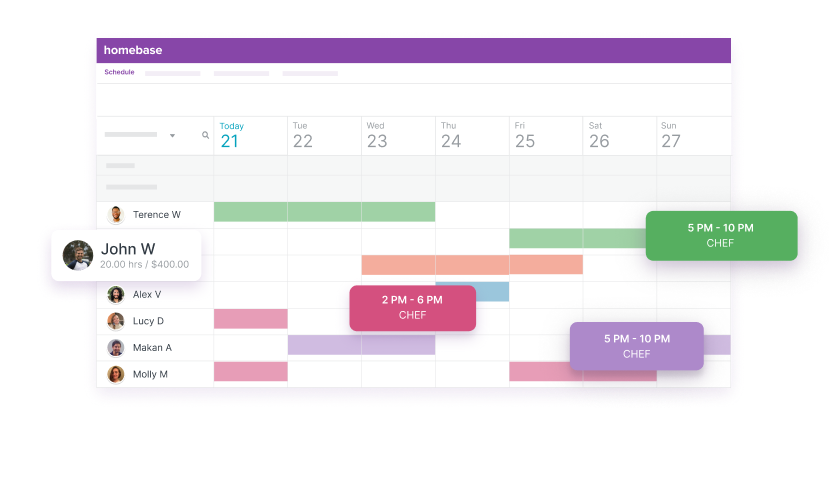Scheduling can turn into a real-life game of Tetris when you’re trying to slot all your different employee shifts into the week. And it’s essential to build a schedule that works for your team to keep employees happy and your business running smoothly.
But there are so many moving pieces in the employee scheduling puzzle it can be hard to keep track. One wrong move and you get scheduling issues like understaffed shifts and too much overtime.
So here’s our guide on making an employee schedule that’ll work for you and set your business up for success.
Why is efficient employee scheduling important?
Effective scheduling is key to keep your business running successfully and smoothly. Let’s look at how error-free and efficient scheduling can benefit you.
Streamline business operations
Businesses can only run as they should when everybody’s in the right place at the right time. A well-designed schedule means no tasks get overlooked or forgotten — you’ll always have the people you need available and won’t keep customers waiting unnecessarily.
You also won’t waste time fixing problems like shift conflicts, so you can focus on the day-to-day operations of your business instead.
Boost employee productivity
Employees perform best when they know what they’re supposed to be doing. The reverse is also true. When employees are unsure about their schedules, they turn up early or late — or not at all. They also have to spend time double-checking their schedules or correcting mistakes instead of focusing on their jobs.
Inconsistent schedules also impact employee morale. Nobody enjoys feeling like they’re failing — especially if it’s not their fault.
Maintain employee satisfaction and decrease turnover
Employees want fair, consistent, and transparent scheduling, so providing them with just that means meeting their needs and keeping them happy. You’ll ensure:
- Everyone has access to desirable shifts and leave
- There’s no second-guessing about unpredictable schedules
- People understand why they have the schedules they do
And when you’re systematic about organizing shifts and use scheduling tools to help you, you can make all that happen and track it, too. Even if your schedule isn’t totally perfect, your employees will be satisfied, leading to higher morale and retention rates.
Manage attendance issues
Ad hoc scheduling makes attendance issues harder to spot. Because when you have unpredictable schedules, you can’t see patterns like an employee being fifteen minutes late every Wednesday.
A great employee scheduling system means you can spot individuals who are struggling with punctuality sooner. Then, you can talk to them, understand whatever’s causing the issue, and take action to resolve it.
Characteristics of a great employee work schedule
Before we move on to creating a schedule, let’s talk about the ideal characteristics to include first. In other words, what exactly does a great employee work schedule look like?
All shifts are covered
The most important characteristic of a great schedule is that every shift is filled. That means no understaffing or having to jump on shift yourself. Regardless of the way you create an employee schedule, there shouldn’t be a single gap.
All positions are filled
Filling all the positions in your schedule is almost as important as covering all your shifts. You don’t want employees doing tasks they’re not trained for or managers doing floor work when they should be focusing on running the business.
A great schedule means having well-trained employees for each position (and enough of them to fill the schedule).
Employee backups in place
It’s impossible to have a backup for every person on every shift, but you can create some contingency plans. Note which employees are available and willing to work during each shift, especially those who live nearby or are often free on short notice. That way, you’ll know who to call first when someone calls in sick.
No scheduling conflicts
Scheduling conflicts lose your business money if you’re overspending on labor. They can also cause problems like overworked or resentful employees, which leads to poor morale and productivity. To decrease scheduling conflicts, eliminate problems like:
- Under or overstaffing shifts
- Employees working very long hours
- Not enough gaps between employee shifts
- Employees working too many shifts in a row
- Too many split shifts
Transparent and easily accessible
Once your schedule is ready, employees need to be able to check it easily and understand why they have the shifts they do. So, schedules need to be somewhere everyone can access, like a website or specialized app.
A great schedule should also make sense to everyone, so managers can encourage employees to speak up if they’re unhappy with their shifts.
In line with rules and regulations
Of course, a good work schedule complies with all federal and state labor laws. This includes:
- Adequate breaks during and between shifts
- No mandatory overtime in states where it’s illegal
- Correct overtime rates
- Giving employees access to their timetables well in advance

6 steps for making an employee schedule
This is our outline for creating an efficient employee schedule for your own business. As every business is different, be sure to tailor each step to your specific needs.
1. Define your scheduling requirements
The first step involves analyzing your business to figure out your scheduling needs and what you can do to satisfy them.
Look into historical trends
Check your old point of sale (POS) data and timesheets to get labor and sales figures. From that, figure out your business’s busy and quiet times.
Sales and labor figures alone won’t give you the full picture. For example, your bar might have average sales on a Wednesday. But if customers are ordering a lot of beer instead of liqueur — which is cheaper but takes longer to serve -— the figures won’t reflect how hard your team is working. So, be sure to check:
Sales:
- Number of transactions
- Average sales totals
- Total sales each person took
Labor:
- Roles on each shift
- Ratio of roles
- Tasks assigned to shifts
- How much time it took employees to do each task
- Set up and clean up times
Identify all employee qualifications
Once you know exactly how many staff members you have and what roles you need them to fill, consider what else they’re capable of. Their skill sets may affect how you choose to organize your shifts.
Your mind might jump to academic qualifications, but consider a broad range of skills and qualifications like:
- Driving licenses
- Healthy and safety courses like first aid training
- Languages spoken
- Soft skills like giving presentations
- Computer skills
And remember, a skill that may seem like a minor detail can end up being make or break. For instance, if your business gets a lot of international tourists, having multilingual employees is a huge asset. You could capitalize on that skill set and have at least one multilingual team member on shift at all peak times.
Analyze available resources
Now, check what other ways you might be able to find staff for your business. This covers a range of possibilities. For example:
- Can you train staff to take on additional roles?
- If your business has multiple locations, can you borrow staff from another branch?
- Are you registered with an agency?
- Could you hire seasonal or one-off employees to cover busy periods?
Don’t be afraid to get creative here. Think about your specific industry and what specific resources you have access to. For instance, plenty of salons and restaurants scout for talent at trade schools, while bars might find temporary staff from other food and drink establishments in the community.
2. Evaluate staffing levels
Now, you have an overview of your business’s needs. Time to look at what your employees are willing and able to do.
Ask for employee availability
Ask your employees when and how much they can normally work during the week. If your business has seasonal highs and lows, check if their availability will change.
Also, talk to employees about their preferred shifts, within reason. It’s not fair for part-time employees to claim all the easy weekday shifts while expecting their full-time colleagues to work Friday to Sunday.
Consider personal time off (PTO) requests
Proactively ask your employees when they’d like to take time off. It’s best to get them to request vacation days well in advance so you can plan ahead.
It’s a good best practice to lay down some time off restrictions, like limiting how many people can be away at the same time. Otherwise, you’ll find that you have too many employees on vacation during the most desirable weeks of the year.
Effective employee vacation tracking is crucial because of how important time off is to people. You can severely damage your relationship with your team by mismanaging PTO and causing them to miss important events or interrupt the time they need to rest and recharge.
3. List employees who work overtime
Before you write your schedule, there’s one last thing on your to-do list. Check your local and state laws and verify that your overtime rate is compliant. You should also make sure you’re not paying more than you budgeted for.
Overtime laws vary according to state and industry, but the standard rule is that businesses have to pay one and half times their employees’ normal rates if they work over 40 hours in a week.
Once you know how much overtime pay you can budget for, ask your team who’s willing to work extra hours. Then, make a list of those people for future reference. You should get plenty of interest as studies show that 93% of employees want more overtime — provided it’s optional.
4. Fill out a work schedule template
Now, you’re ready to use all the above information to create an employee scheduling template. The best strategy is to schedule staff members in the following order:
- Management
- Senior full-time employees
- Newer full-time employees
- Senior part-time employees
- Newer part-time employees
Before you finalize your schedule, check that every detail is correct, including dates, times, locations, and — very important but sometimes overlooked — employee names.
5. Publish your schedule in advance
Be sure to publish your schedule at least two weeks in advance, if not more. Employees feel happier knowing when they’re working, and many people need to plan childcare, school, or second jobs around their shifts, too.
Plus, there’s evidence that last-minute schedules won’t help your business either. Some businesses practice just in time scheduling and on call scheduling to save on labor costs but end up losing money due to the high turnover rates and damage to their reputations. Some states are also introducing a predictive scheduling law to end these kinds of practices.
Sharing your schedule in advance saves you some headache, too. The earlier you publish it, the more time you have to solve problems and make changes.
6. Review schedules regularly
Resist the temptation to reuse the same schedule every week. Your business’s needs change constantly, so you need to ensure your current schedule is up to date with current sales figures, labor costs, and budgets. Besides, Homebase’s scheduling tool lets you make tweaks easily.
Make a habit of reviewing sales and labor costs, as well as staffing levels. Also, stay up to date with your local labor laws so you don’t miss any changes that could affect your business.
Your team needs will change, too. Ask team members to tell you about shifts in their availability immediately so you can adapt your schedule. It might not always be bad news — for example, some people’s availability increases when their young children start school.

Best practices for making an employee schedule
There are some extra steps you can take to avoid scheduling issues and maximize team productivity. Here’s our list of best practices for scheduling.
Plan ahead for workload spikes
When you expect your business will get busier than usual, strategize to fill your staffing needs. You can try:
- Incentivizing less desirable shifts with rewards
- Listing additional ‘open shifts’ for employees to claim
- Rescheduling non-urgent tasks to quieter times
- Hiring seasonal workers like students
Keep employees in the loop at all times
Communication is key to effective scheduling, so it’s vital to use a scheduling tool that sends out alerts when problems come up, answers employee questions, and sends everyone regular updates.
Some businesses have a team chat on an app like Whatsapp, but that can quickly lead to vital information getting lost in the feed. Instead, consider a dedicated team communication tool. Homebase’s messenger lets you message individuals or the whole team to send notifications, share updates, and check in with employees.
Have a contingency plan in place
No matter how well you plan, scheduling issues will inevitably come up because of everything from sick days to bad weather. To account for all those eventualities, you’ll need a contingency plan in place.
If you have some advance notice about a scheduling issue, get your employees to shift swap or put up open shifts for people to claim. You might already have a team member looking for different or extra shifts, and that’ll solve your problem for you. Homebase lets you do this on their app — all you have to do is click approve!
Make use of employee scheduling software
Some businesses rely on Microsoft Excel spreadsheets and other scheduling ideas to create their employee timetables. But spreadsheets are time-consuming and leave lots of room for error. Plus, you can’t make quick edits.
Consider using a solution like Homebase’s employee scheduling tool instead — you can even use our free weekly schedule template. Our platform also lets you input your team’s availability and preferences so you can automate schedules and easily make last-minute changes when someone calls in sick.
Homebase does so much more than employee scheduling
Looking for an easier way to manage scheduling that’s time and cost-effective but doesn’t create more shift conflicts? Homebase’s free employee scheduling feature lets you create weekly schedule templates automatically. Keep your team happy and avoid shift conflicts by basing your schedule on your employees’ roles, availability, and preferences. And all the while, keep your team in sync with our team communication tool.
When you approach scheduling strategically instead of rushing through it on a week-by-week basis, it pays off. Your schedule can work for you instead of against you.
FAQs about making a schedule for employees

What is the best way to schedule employees?
The best way to schedule employees is to:
- Define your scheduling requirements
- Evaluate staffing levels
- List employees who work overtime
- Fill out a work schedule template
- Publish your schedule in advance
- Get feedback and review your schedule regularly
What are the 4 types of work schedules?
The four work schedule types are:
- Full-time: Schedules with more than 30 hours.
- Part-time: Schedules with fewer than 30 hours.
- Flexible: Schedules that change between full and part-time hours.
- Alternative: Schedules outside standard working hours. For example, weekends and night shifts.
What is the most common work schedule?
Full-time is the most common work schedule. Typically, full-time employees work from around 9am to 5pm (with a break for lunch) from Monday to Friday for 35 to 40 hours per week.
